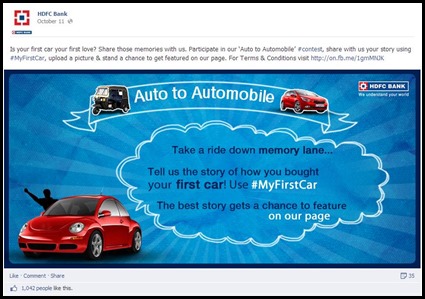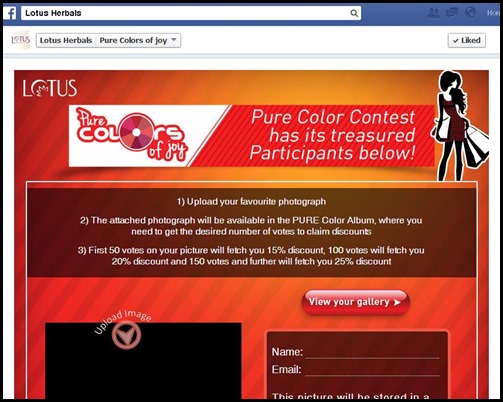 With timeline contests brands could ask users to enter with a like, comment or posting a message on the page. A ‘Like’ here can be termed as a sort of voting mechanism. Though it appears small, but here the barrier to entry is very small as fans can enter with a single click. And if brand managers wish to engage with their existing brand fans then this is a great way to do that. Where contests through apps encourage collection of email addresses, new likes and all such details, wall or timeline contests don’t do that. But if there is a well planned social media strategy, app contests turn out be great!
With timeline contests brands could ask users to enter with a like, comment or posting a message on the page. A ‘Like’ here can be termed as a sort of voting mechanism. Though it appears small, but here the barrier to entry is very small as fans can enter with a single click. And if brand managers wish to engage with their existing brand fans then this is a great way to do that. Where contests through apps encourage collection of email addresses, new likes and all such details, wall or timeline contests don’t do that. But if there is a well planned social media strategy, app contests turn out be great!
Well, if you are thinking as to what should you opt for; a Timeline contest or contest hosted on a tab on your Facebook Page? And when, then here’s a summation of the facts that will help you get through your brand contests on Facebook, whether you want to do a timeline or an app contest.
Both of these types have the pros and cons linked to each. The essence is in understanding the overall brand strategy and goals that have to be achieved through the same. And therefore, which one should be used or both should be used in collaboration. In other words, Timeline contests are more of an appetizer while contests on tabs turn out to be full course meals.
Timeline contest is great when:
- · One wants to launch a contest right away
- · High engagement is the requirement
- · Low budget
It sure gives an engagement boost for the Facebook page of brands.
If at any point you want a promoted post on your timeline contest, it cannot be illustrated by an image containing more than 20% text.
On the other hand,
Contest hosted on the Facebook page tab work best when:
- · One wants to grow the Facebook page likes (includes a Like Gate page that prompts the users to first like the page to enter the contest)
- · You want to foster Lead generation, email adresses for future marketing of your brand
- · Design control and advanced features is a part of your overall contest strategy
Therefore, a Facebook contest on tab gives you great control, customization and long term value of your lead generation.
This is how a Timeline contest works:
Future Generali came up with a Timeline contest during Navaratri. Check it out:
HDFC Bank’s Timeline contest Auto to Automobile is another good example.
And here is an example for an app contest:
Check out how Lotus Herbals, India’s leading natural cosmetics company with formulations inspired by Ayurveda is running an app contest Pure Colors of Joy!
Will these changes affect the Facebook marketing strategy of your brand?
Timeline contests are simple, i.e., fans are just required to like, comment, post their response or message on the Facebook page of the brand, out of which the winner is manually chosen. Timeline contests are free to run if you do not advertise and are mobile friendly too.
So, then, what are the limitations to running a contest on the timeline?
- Reduced virality as fans cannot share the page posts. Where sharing is one of the greatest & most viral features of Facebook, not being used to its potential means limiting it just to the existing fans (unless of course you run ads).
- Managing entries becomes a problem at one point as more the number of fans, more the engagement, more the likes, comments and entries etc; it becomes a great challenge to manage the entries as the numbers become high.
- Terms & Conditions cannot be displayed when running a contest on the Facebook timeline. Every contest comes with certain rules linked to it. But, there may be cases when fans directly take part in your contest by just liking the post etc. which can later result into dissatisfaction from fans.
- There is no lead generation when a timeline contest is run as there is no registration for the same neither are details like name, email addresses accumulated.
The reach is very limited as the contest run on a timeline can only be promoted using posts that talk about the contest unlike the app contests wherein multiple updates with a link to the app can be done.
So, does that mean Facebook Contest apps are anytime better?
Well, app contests do come with certain benefits like:
Allowing Social Sharing by fans on all social media platforms
Social Stories: when a fan interacts with an app, a newsfeed story is generated that is visible to friends of fans gaining more traffic to the contest
Offering customized fan experience by using custom brand videos, graphics, design etc. that in the end creates more brand recall.
Therefore, in this social battle of contests hosted on timeline and those on an app, apps stand as the winner!
However, you can also think of combining them both for a double advantage where you can:
- · Manage your contest entries
- · Analyze them under parameters of most likes, comments & responses.
- · You can display contest rules & let your fans submit all details etc.
- · Use it as a mobile-friendly app as it helps incorporate all the features mentioned
Source: antavo.com, https://www.facebook.com/page_guidelines.php, https://www.facebook.com/faceboofforbusiness/news/page-promotions-terms
In a nutshell, if you wish to engage with your Facebook brand fans then run a timeline contest but if you wish to garner more likes and data to reach fans out of Facebook then apps are best. Brands can also try using both these methods in collaboration. The ‘TAT’ (talking about this) number of the pages can be raised with a timeline contest so that more posts are visible to the fans and then you can run an app contest to get more likes etc.
So are you all set to let your fans experience the best of both worlds? What would you, as brand managers try? Timeline contests or contests through apps? Do share in your thoughts with us.
















![clip_image002[6]_thumb[2]](https://windchimes.co.in/blog/wp-content/uploads/2011/11/clip_image0026_thumb2_thumb.gif)
![clip_image004[6]_thumb[2]](https://windchimes.co.in/blog/wp-content/uploads/2011/11/clip_image0046_thumb2_thumb.gif)
![clip_image006[6]_thumb[2]](https://windchimes.co.in/blog/wp-content/uploads/2011/11/clip_image0066_thumb2_thumb.gif)
![clip_image008_thumb[2]](https://windchimes.co.in/blog/wp-content/uploads/2011/11/clip_image008_thumb2_thumb.gif)
![clip_image010_thumb[2]](https://windchimes.co.in/blog/wp-content/uploads/2011/11/clip_image010_thumb2_thumb.gif)
![clip_image012_thumb[2]](https://windchimes.co.in/blog/wp-content/uploads/2011/11/clip_image012_thumb2_thumb.gif)
![clip_image014_thumb[2]](https://windchimes.co.in/blog/wp-content/uploads/2011/11/clip_image014_thumb2_thumb.gif)
![clip_image016_thumb[2]](https://windchimes.co.in/blog/wp-content/uploads/2011/11/clip_image016_thumb2_thumb.gif)







